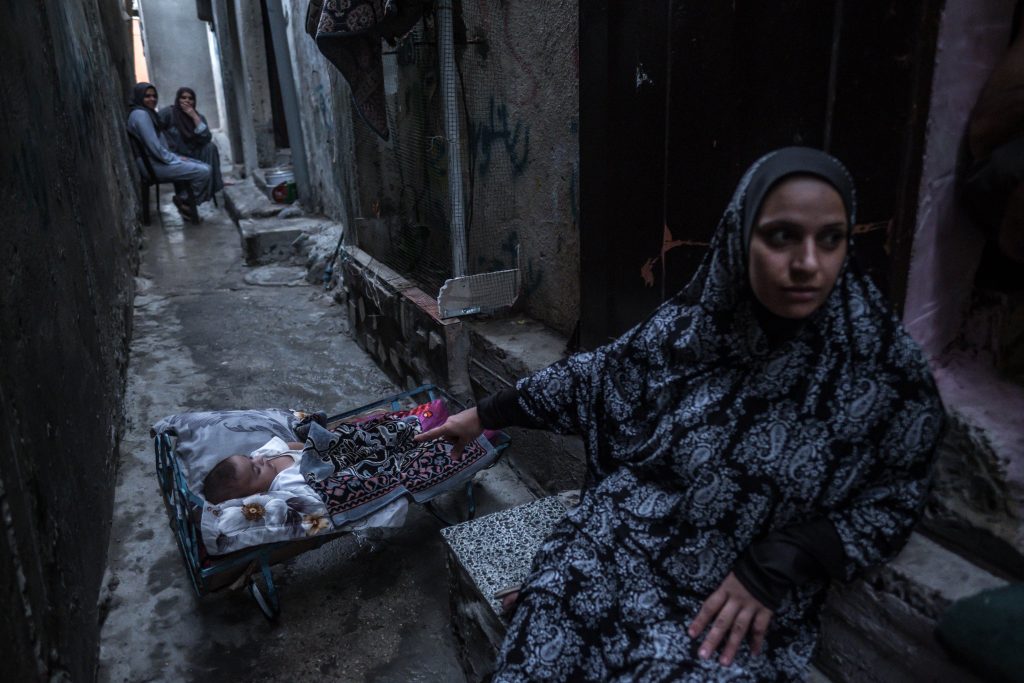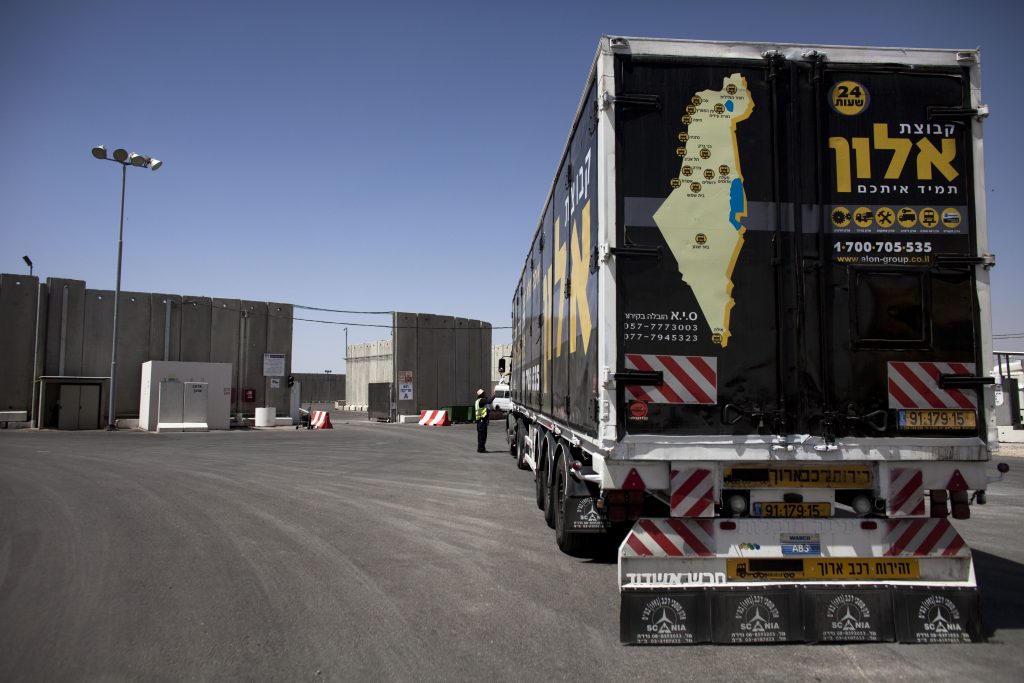The water crisis in Gaza is a problem of daunting proportions, with grave implications for the more than 2 million inhabitants of the besieged Palestinian enclave.1 The narrow 365-square-kilometer strip has no perennial source of surface water, and is completely blockaded by Israel and Egypt on all sides. The aquifer from which it pumps water is diminishing, but more dangerously, it is experiencing significant deterioration from seawater and highly saline groundwater intrusion, as well as pollution. As Gaza runs out of potable water, there is a real likelihood of a large-scale humanitarian disaster that will make the territory’s current tribulations—grave as they already are—much worse.
But the crisis of water in Gaza also holds promise. An effective response can have positive reverberations far beyond the realm of water provision. That’s because Gaza’s water problem will require cooperation between antagonists, to their mutual benefit. There is no solution that can be achieved by Gaza or Israel in isolation; both have an interest in solving the crisis before it further impacts regional environmental and public health.
Addressing Gaza’s need for water can open the door to other forms of cooperation, and in the current political climate, genuine cooperation in the environmental and humanitarian field could enable positive transformation of the conflict. Further, effectively addressing the problem of water in Gaza is directly associated with a universally acknowledged vital human need, more so than any other area of dispute between Israel and the Palestinians. As such, it holds more possibility as an area in which to collaborate.
This is not to say that solving the worsening water crisis in Gaza will be easy. All the problems in Gaza are intertwined with others. A solution will require delicacy, a complete understanding of the controversies surrounding water, and the assertive and fair involvement of the international community.
There is, however, a simple way to start. The United States and the international community should support the importation of bulk water from Israel through a multi-year arrangement. This action would offer a combination of environmental, water, and human security benefits that would decrease political tensions between Palestinians and Israelis. The initiative would further allow UN institutions and donors valuable time to support the implementation of the ongoing Palestinian strategy to respond to the water crisis—the 2011 Gaza Program of Interventions (PoI)—in conjunction with a broader program of reform of the water sector.2
Both Israel and the Palestinians will need to embrace at least limited cooperation for the greater good.
This report recalls the origins of Gaza’s water and environmental disaster. It critically reviews assessments by the international community that have sought to address Gaza’s water crisis (such as the World Bank’s 2009 “Assessment of Restrictions on Palestinian Water Sector Development”), as well as the integrated PoI, as the basis of the Palestinian response.3 Selected from a broader menu of options, the Palestinian Water Authority (PWA) set aside a number of recommended interventions due to political impediments, including the blockade of Gaza by Israel and Egypt since 2007. Importantly, Palestinian officials have always emphasized that the PoI could only successfully mitigate the water crisis if the enabling environment to humanitarian and development efforts—such as availability of essential materials and sustainable electrical supply—was meaningfully improved. Thus, while Israeli provision of water to Gaza would undeniably benefit both parties, it will also require Israel to relax at least one aspect of its blockade. Both Israel and the Palestinians will need to embrace at least limited cooperation for the greater good.
A Worsening International Disaster
Decades of overpumping groundwater have caused Gaza’s underlying aquifer to deteriorate. This overpumping has resulted in a correspondingly dramatic impact on the ecosystem, economic livelihoods, and human health of more than 2 million inhabitants of Gaza. Only 5 percent of the available water resources in the territory are fit for human consumption. And this figure actually understates the problem: that 5 percent includes the small volumes of fresh water that Israel sells and transfers. Without Israel’s sale and transfer of this water, only 2 percent of water sources in Gaza would be fit for human consumption.
A lack of progress in water and sanitation investments has compounded the impact of groundwater deterioration on the public health of Gaza. Both salinity and nitrate levels in the groundwater have been well above World Health Organization (WHO) guidelines for safe drinking water.4 A 2018 report from the RAND Corporation, “The Public Health Impacts of Gaza’s Water Crisis: Analysis and Policy Options,” studied water-related risks in Gaza, and noted that poor water quality and lack of access to water contributed to more than a quarter of all reported diseases in the strip.5 More than 50 percent of Gaza’s children suffer from water-related parasitic infections and chronic diarrhea, which affect child growth and development.6 A recent health risk assessment found that nitrate levels in Gaza exceed the WHO limit in 91 percent of municipal wells (223 of 245 wells), and that nitrate levels are unacceptable for children and infants’ drinking purposes in all wells.7 Nitrate contamination is linked to “blue baby syndrome” (also known as cyanosis), affects pregnant women, and may increase the risk of certain types of cancer. Moreover, adults and children are at risk of a range of water-related diseases, since drinking saline water can cause kidney dysfunction, heart failure, neurological symptoms, lethargy, and high blood pressure. The water, sanitation, and hygiene crisis renders Gaza’s inhabitants acutely vulnerable to the outbreak of disease—waterborne or otherwise.8

The health impacts of Gaza’s water crisis will not be contained within its borders. The RAND report highlighted that the combination of poor water supply, limited hygiene practices, and insufficient sewage treatment in Gaza could lead to a disease outbreak that spreads outside of the territory. Israel, too, has recognized this danger. The Israeli state comptroller has identified water pollution as Israel’s most serious cross-border environmental hazard, highlighting that such widespread pollution not only degrades the groundwater quality of Israel and its neighbors, but also harms public health and the quality of life.9
In a recent example of the perniciousness of such transboundary problems, at press time COVID-19 was on the verge of “overwhelming” Gaza’s hospitals. A major outbreak there will surely have repercussions in Israel.10 The pandemic is a stark illustration of the impossibility of segregating Gaza’s health outcomes from those of the region, let alone those of Israel.
The world has come together in universal political commitment to the Sustainable Development Goals—the seventeen targets that the UN has set for global achievement by 2030. But the goals of sustainable development for the inhabitants of Gaza are simply unattainable absent the broad application of international law. Without the removal of the existing blockade, Palestinians will almost certainly fail to implement the Gaza PoI that is meant to stabilize the water crisis. Palestinians and the international community have attempted a variety of measures for years—and are often compelled to advance suboptimal interventions—to address the worsening water and ecological situation in Gaza. But all responses are inescapably framed by the normalization of the initial displacement of several hundred thousand Palestinians to Gaza in 1947–49, the geographical diminution of Gaza, and the Israeli military’s control over inhabitants, which has increased since 1967.
While solutions to Gaza’s plight may be out of reach without larger political and legal remedies, it is still possible to significantly mitigate the water crisis. The international community can work to stabilize the worsening environmental and health impacts.
But while solutions to Gaza’s plight may be out of reach without larger political and legal remedies, it is still possible to significantly mitigate the water crisis. The international community can work to stabilize the worsening environmental and health impacts. And preventing matters from deteriorating further can provide a foundation for more substantial improvements down the road.
An Artificial Shortage of Water
In ancient times, Gaza was known for the quality of its groundwater, which afforded sustenance and livelihoods to its inhabitants. Water resources provided a high quality of life for the inhabitants until the 1947–49 conflict that erupted around the founding of Israel. In the 1940s, less than a decade before the end of the British Mandate period in Palestine, the district known as Gaza comprised an area of land some three times larger than today’s enclave, but held a population of only 151,000, for a population density of just 137 people per square kilometer.11 At the time, the inhabitants of Gaza used 27 million cubic meters per year (mcm/y) of groundwater. As we search for an effective response to Gaza’s water crisis, it is important to understand how Gaza—once admired for its plentiful water—became so crowded, and its groundwater so overdrawn.
In 1947–49, some 200,000 Palestinians from 247 villages in southern Palestine (territory that is now Israel) were displaced to Gaza.12 Palestinians refer to these events—and the displacement of hundreds of thousands of other Palestinians out of their ancestral lands—as the “Nakba,” or the Catastrophe. While Israel contests the history of these events, for Palestinians, there is no doubt that this displacement was forced. The Nakba might be compared to the nineteenth-century Trail of Tears in the United States, in which the government transferred Native Americans from their historic lands in the southeast to Oklahoma (then known as the Indian Territories).13 For Palestinians, the newly established Israel was advancing a twentieth-century version of Manifest Destiny.
Then, Gaza began to shrink. The February 1949 Egyptian–Israeli Armistice Agreement reduced the size of Gaza’s territory by half.14 In 1950, a secretly negotiated amendment to the agreement reduced the territory by another 17 percent compared to its prewar size.15 The diminished enclave then had only sixty-two wells providing 2 mcm/y of water—about 7.5 percent of British Mandate Gaza’s prewar water supply, for a smaller area whose population was suddenly three and half times as big.16 From the outset, the Gaza Strip was compelled on a downward path of unsustainability.
Today, Gaza has more than 5,600 inhabitants per square kilometer—one of the most densely populated polities in the world. The enclave, with a territory now slightly larger than double the size of Washington, D.C., today has access to 101 mcm/y for domestic supply.17 The section of land that today’s Gaza Strip comprises has a population that has increased more than twenty-five times—and water sources that have not.18 It is thus little wonder that today, Gaza’s water resources are under extreme stress.

Throughout the world, large urban environments are not water resource self-sufficient, but rather depend on the transfer of water supply from hinterlands or remote areas. But being under siege and completely isolated, Gaza has no hinterland, and is in a singularly desperate situation when it comes to water.
The inhabitants of Gaza are almost completely dependent on the underlying groundwater from the Coastal Aquifer as their principal water resource. Running from Mount Carmel in northern Israel to the Sinai in Egypt, the Coastal Aquifer is a classic transboundary aquifer whose management is addressed by customary international water law. The primary substantive principle of such law is “equitable and reasonable utilization,” which emphasizes the primacy of “vital human needs” in the management of the resource.19 Despite having other natural water resources, Israel has consistently drawn 75 percent of the sustainable groundwater amount each year from the Coastal Aquifer, which almost certainly exceeds its fair share under international water law. With no alternative water resource, an overpopulated Gaza pumps beyond the sustainable groundwater amount each year. Highly saline inflows, including seawater from the Mediterranean, rush in through porous geological formations to fill what hydrogeologists call a “depression.”
Gaza’s ecological disaster happened not only under Israel’s watch—but also because of Israel’s five decades-plus of occupation and control. And understanding this fact is important for creating an effective remedy.
The history makes it clear that Gaza’s ecological disaster happened not only under Israel’s watch—but also because of Israel’s five decades-plus of occupation and control. And understanding this fact is important for creating an effective remedy.


